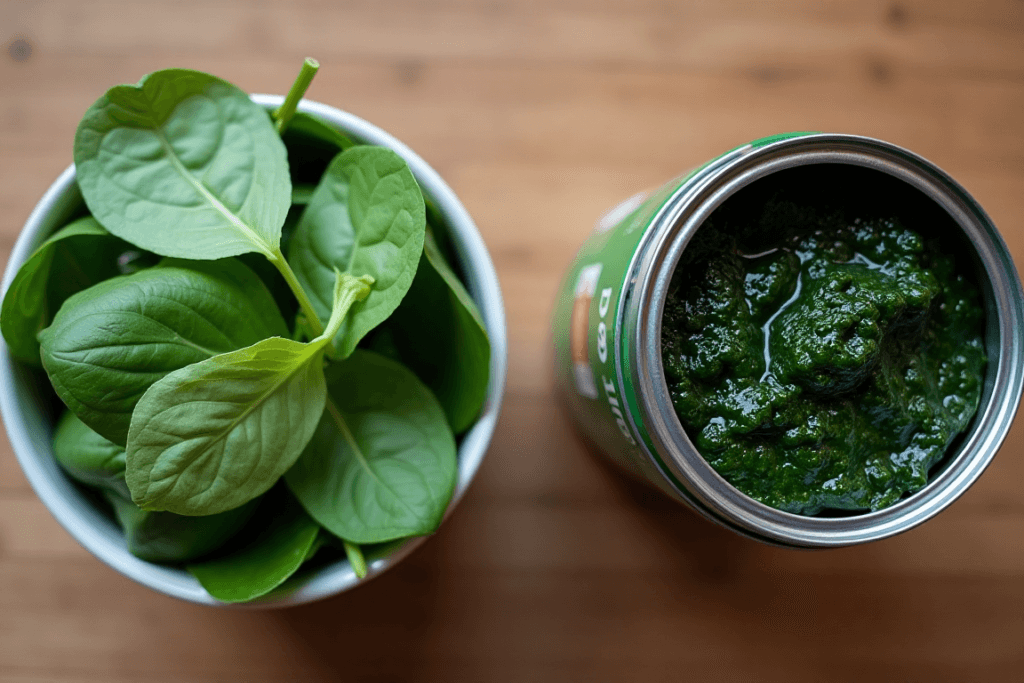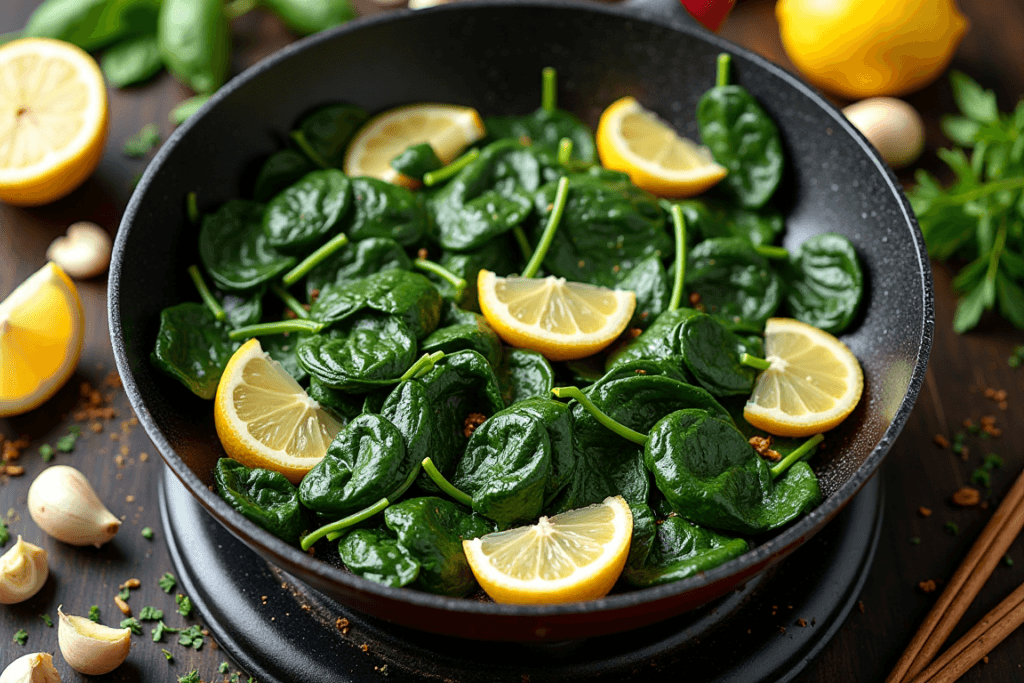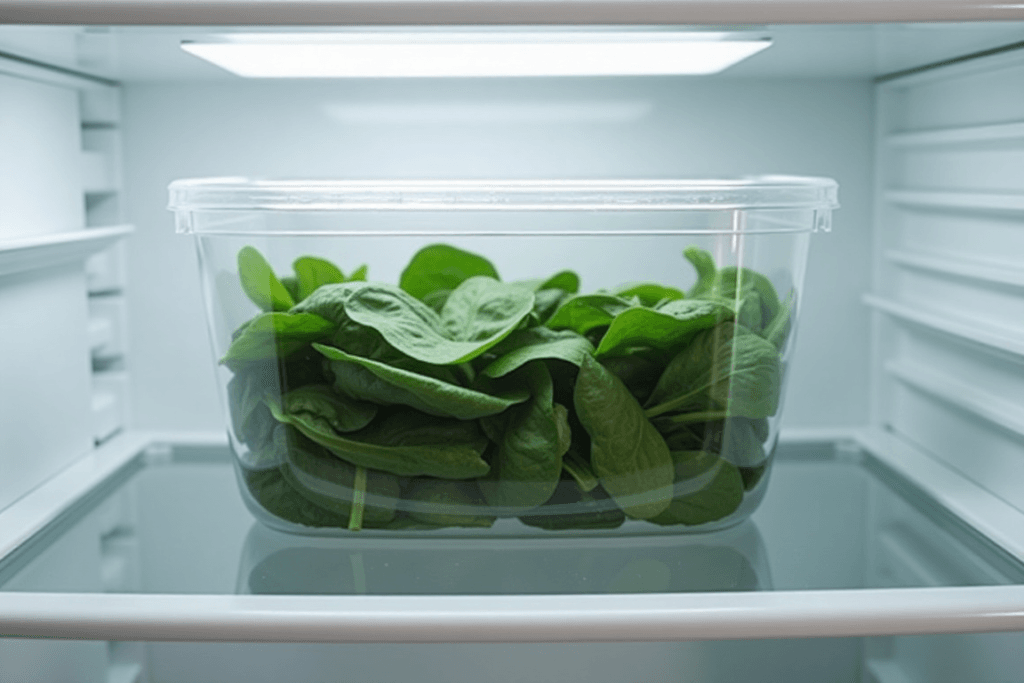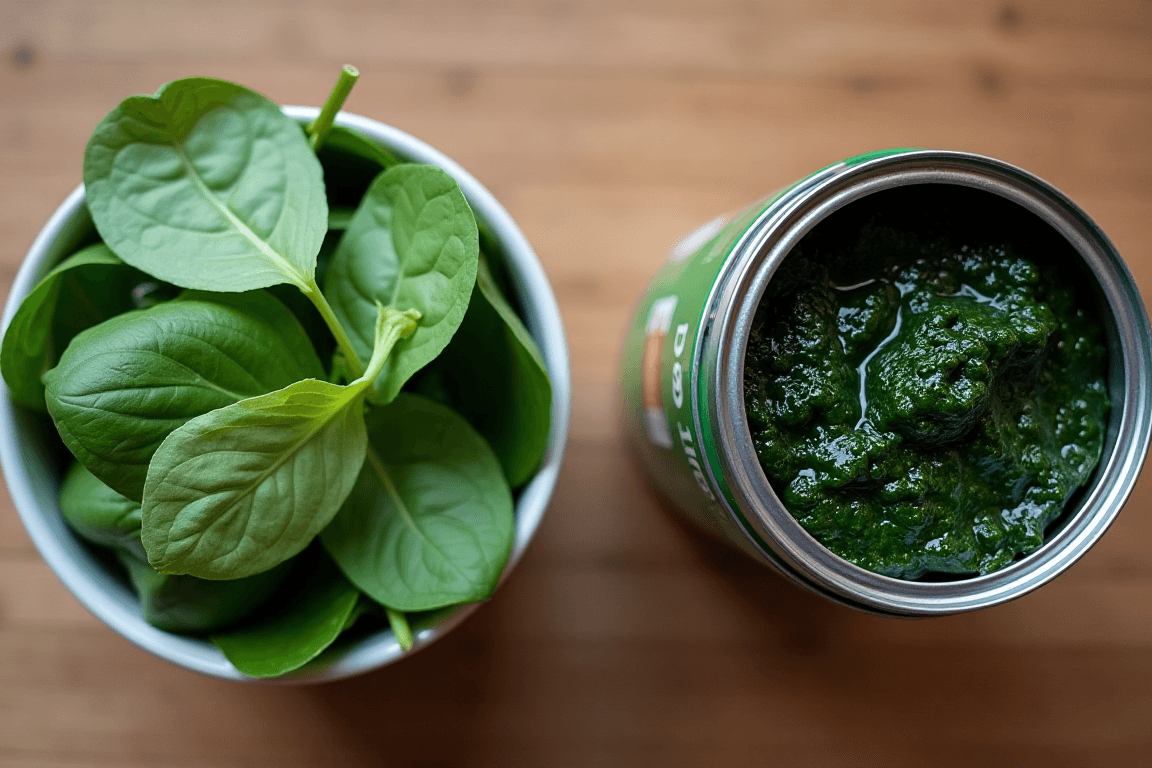Spinach, a leafy green vegetable loaded with nutrients, is a staple in kitchens worldwide. Whether used in smoothies, soups, or sautés, it adds flavor and nutrition to countless dishes. But what happens when a recipe calls for fresh spinach, and you only have canned spinach in your pantry? Is it possible to make the swap? In this article, we’ll explore the feasibility of substituting canned spinach for fresh spinach, including the pros, cons, and practical tips to make your dishes delicious.

Understanding Spinach Varieties
Spinach comes in several forms, each with its unique qualities and uses. Understanding the differences between fresh and canned spinach is key to deciding if and when they can be substituted in recipeTypes of Spinach Available
Fresh Spinach
Fresh spinach is the most versatile option, found in many forms like baby spinach and mature spinach leaves. It’s a favorite for salads, sandwiches, and recipes where texture and crispness are desired. Fresh spinach retains its bright green color and has a delicate, slightly earthy flavor that can elevate any dish.
Canned Spinach
Canned spinach, on the other hand, is pre-cooked and preserved in liquid. It is soft, compacted, and often darker in color. The canning process changes its texture and concentrates its flavor, making it suitable for cooked dishes like casseroles, soups, and dips.
Frozen Spinach
Frozen spinach is another common option and strikes a balance between fresh and canned varieties. It is usually blanched and frozen in blocks or loose leaves, preserving much of its fresh flavor while being convenient for cooking.
Nutritional Differences Between Canned and Fresh Spinach
Vitamins and Minerals
Both canned and fresh spinach are rich in essential vitamins like A, C, and K and minerals such as iron, calcium, and magnesium. However, the cooking process involved in canning can slightly reduce water-soluble vitamins like vitamin C.
Sodium Content
One of the most noticeable differences is the sodium content. Canned spinach often contains added salt as a preservative, which can be a concern for those monitoring their sodium intake. Fresh spinach has negligible sodium levels, making it a better choice for low-sodium diets.
Fiber and Calories
Both varieties provide similar amounts of dietary fiber, supporting digestive health. Canned spinach is slightly denser because it has been cooked down, which may result in higher calorie content per serving compared to fresh spinach.
When to Substitute Canned for Fresh
While substituting canned spinach for fresh spinach isn’t always ideal, it can be done effectively in certain circumstances. Understanding when and how to make this substitution ensures your dish remains flavorful and nutritious.
Cooking Methods Where Canned Spinach Works Well
Soups and Stews
Canned spinach integrates seamlessly into liquid-based dishes like soups and stews. Its softened texture blends easily, and its concentrated flavor complements broths and seasonings.
Casseroles and Pasta Dishes
In baked dishes such as casseroles or lasagna, canned spinach works well because the texture differences are less noticeable after cooking. It’s a convenient way to add greens to hearty, rich meals.
For a delicious spinach-based dish, try Quiche Florentine: A Delicious Spinach and Cheese Delight.
Smoothies and Purees
For smoothies or purees where texture isn’t critical, canned spinach can substitute fresh spinach. Ensure it’s well-rinsed to remove any residual sodium or metallic flavor.
Recipes Where Substitution Might Alter Flavor or Texture
Salads
Canned spinach is not ideal for salads because of its mushy texture and strong flavor, which can overpower other ingredients. Fresh spinach is the gold standard for salads due to its crisp, light quality.
Stir-Fries and Light Sautees
In recipes where spinach is lightly cooked or added last, fresh spinach performs better. Its ability to wilt slightly while maintaining structure and flavor makes it preferable for these methods.
Adjusting Quantities When Substituting
When substituting canned spinach for fresh, remember that canned spinach is already cooked, significantly reducing its volume. As a general rule of thumb:
- 1 cup of fresh spinach cooks down to about 1/4 cup of canned spinach.
- For recipes calling for fresh spinach, use about 1/3 to 1/2 the amount of canned spinach to achieve similar results.
Benefits of Using Canned Spinach
Canned spinach might not be the first choice for many recipes, but it has several advantages that make it a practical option. Here’s why you might consider using canned spinach instead of fresh.
Convenience and Long Shelf Life
Ready-to-Use
Canned spinach is pre-cooked, saving time in the kitchen. There’s no need for washing, chopping, or cooking it down—making it ideal for busy cooks or last-minute meals.
Extended Shelf Life
Unlike fresh spinach, which wilts and spoils quickly, canned spinach has a significantly longer shelf life. It’s perfect for stocking up your pantry and ensuring you always have a nutritious ingredient on hand.
Portability
Canned spinach is portable and doesn’t require refrigeration until opened, making it a practical option for outdoor activities like camping or road trips.
Cost-Effectiveness Compared to Fresh Spinach
Lower Initial Cost
Canned spinach is often less expensive than fresh spinach, particularly in regions where fresh produce is costly or seasonal availability is limited.
Reduced Waste
Since canned spinach doesn’t spoil as quickly as fresh, you’re less likely to waste unused portions. Additionally, it is fully edible without the need to discard stems or wilted leaves, maximizing the value of every purchase.
Bulk Availability
Canned spinach is sold in various sizes, making it easy to purchase the right amount for your cooking needs. Larger cans can cater to family meals, while smaller options are perfect for single servings.
Minimizing Food Waste
Utilizing the Whole Product
Canned spinach eliminates waste by being entirely edible—there’s no need to trim stems or remove bruised leaves, as you often do with fresh spinach.
No Spoilage Concerns
Fresh spinach has a short shelf life, even when stored properly, and often goes bad before it can be used. Canned spinach, on the other hand, stays safe and usable for months, reducing overall food waste.
Easy Storage of Leftovers
Unused canned spinach can be stored in an airtight container in the refrigerator for several days, allowing you to use it in multiple recipes without spoilage.
Potential Drawbacks of Substitution
While canned spinach has its merits, it’s not a perfect replacement for fresh spinach in every scenario. Here are some limitations to consider.
Differences in Taste and Texture
Altered Flavor Profile
Canned spinach has a more concentrated and slightly metallic flavor due to the canning process. This can affect recipes that rely on the fresh, mild taste of spinach.
Softer Texture
The texture of canned spinach is soft and mushy, which can be undesirable in recipes like stir-fries or salads where a firm, crisp texture is preferred.
Sodium Content in Canned Spinach
High Sodium Levels
Many brands of canned spinach contain added salt as a preservative, which can be problematic for those on a low-sodium diet. This can also influence the overall saltiness of your dish.
Mitigating the Issue
You can reduce sodium content by thoroughly rinsing canned spinach under cold water before using it. Opting for low-sodium or no-salt-added varieties is another effective strategy.
Environmental Considerations
Packaging Waste
The metal cans used for canned spinach contribute to packaging waste. While recyclable, the environmental footprint of canned goods is higher compared to fresh produce when packaging and transportation are factored in.
Energy Use in Canning
The canning process requires significant energy inputs, which can make canned spinach less sustainable compared to locally sourced fresh spinach.
Tips for Substituting Successfully
Substituting canned spinach for fresh spinach requires a few adjustments to ensure your dishes remain flavorful and satisfying. These tips will help you make the most of canned spinach in any recipe.
Rinsing and Draining Canned Spinach
Why Rinse Canned Spinach?
Rinsing canned spinach removes excess sodium and any metallic taste from the canning liquid. This simple step can significantly improve the flavor of your dish.
Proper Draining Techniques
After rinsing, drain the spinach thoroughly by pressing it with a strainer or patting it dry with paper towels. Removing the excess liquid prevents your dish from becoming too watery, especially in recipes like casseroles or dips.
Enhancing Flavor with Additional Ingredients

Adding Fresh Herbs
Since canned spinach lacks the vibrant flavor of fresh spinach, consider adding fresh herbs like parsley, basil, or dill to brighten the dish.
Using Citrus and Spices
A squeeze of lemon juice or a dash of nutmeg can enhance the flavor of canned spinach, masking any overly concentrated or metallic notes.
Incorporating Aromatics
Cooking canned spinach with garlic, onions, or shallots can infuse it with a more complex and appealing taste.
Adjusting Cooking Techniques
Minimizing Overcooking
Since canned spinach is already cooked, avoid overcooking it in your recipes. Brief reheating is usually sufficient to maintain its texture and flavor.
Blending in Soups and Sauces
For creamy soups or sauces, blend canned spinach to create a smooth texture. This technique works particularly well in dishes like spinach soup or pasta sauce.
Layering in Baked Dishes
Use canned spinach as a filling or layer in baked dishes like lasagna, quiche, or spanakopita. Its soft texture blends seamlessly with other ingredients, creating a cohesive dish.
Need ideas? Try recipes from 15 Best Chicken and Spinach Recipes for Every Occasion.
Frequently Asked Questions (FAQs)
Is canned spinach as healthy as fresh spinach?
Canned spinach retains many of the same nutrients as fresh spinach, including vitamins A and K, iron, and fiber. However, it may have reduced levels of water-soluble vitamins like vitamin C due to the heat involved in canning.
How do I reduce the saltiness of canned spinach?
To lower the salt content, rinse canned spinach under cold running water for at least 30 seconds and drain it thoroughly. Opting for low-sodium or no-salt-added varieties can also help.
Can I use canned spinach in salads?
Canned spinach isn’t ideal for raw salads because of its soft texture. However, it can be added to warm salads or used in recipes that incorporate wilted greens.
How do I store leftover canned spinach?
Leftover canned spinach should be transferred to an airtight container and refrigerated. It will stay fresh for up to three days. Avoid leaving it in the opened can to prevent metallic flavors from developing.
What are some recipes that use canned spinach effectively?
Canned spinach works well in dishes like spinach and artichoke dip, spanakopita, pasta sauces, omelets, and soups. Its soft texture and concentrated flavor make it ideal for recipes that involve cooking or blending.
Are there alternatives to both canned and fresh spinach?
Yes, frozen spinach is an excellent alternative. It offers a balance between the freshness of raw spinach and the convenience of canned spinach. Other leafy greens like kale, Swiss chard, or collard greens can also be used as substitutes.

Conclusion
Substituting canned spinach for fresh spinach is a practical solution in many recipes, provided you understand the differences between the two. While fresh spinach excels in dishes that require crispness and vibrant flavor, canned spinach brings convenience and a long shelf life to the table. With proper preparation, such as rinsing and draining, you can minimize its drawbacks and make it work in a wide range of dishes, from soups to casseroles.
The key to successful substitution lies in knowing the strengths of canned spinach and tailoring your recipes to suit its texture and taste. Whether you’re preparing a hearty lasagna, a creamy soup, or a quick weeknight meal, canned spinach can be a versatile ingredient when fresh spinach isn’t an option. By applying the tips and strategies discussed in this article, you can confidently use canned spinach to create delicious and nutritious meals.

